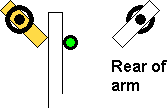|
|
|
|
|
|
|
|
|
From early 1929, warning signals on the Southern Railway had arms with no distinguishing letter "W" fitted [3.67]. When cleared, a letter "W" was displayed in a separate indicator placed alongside the arm [3.68 & 3.69]. In some instances, the same arm was also able to function as either a calling-on signal or a shunt-ahead signal by the indicator displaying a letter "C" [3.70 & 3.71] or "S" [3.72 & 3.73], respectively.
 |
|
[3.67] Subsidiary Signal ('on').
Area: Southern Railway Usage: Medium Status: Historical |
|---|
 |
 |
|
[3.68] Lower Quadrant Warning Signal ('off').
Area: Southern Railway Usage: Medium Status: Historical |
[3.69] Upper Quadrant Warning Signal ('off').
Area: Southern Railway Usage: Medium Status: Historical |
|---|---|
 |
 |
|
[3.70] Lower Quadrant Calling-on Signal ('off').
Area: Southern Railway Usage: Low Status: Historical |
[3.71] Upper Quadrant Calling-on Signal ('off').
Area: Southern Railway Usage: Low Status: Historical |
 |
 |
|
[3.72] Lower Quadrant Shunt-ahead Signal ('off').
Area: Southern Railway Usage: Low Status: Historical |
[3.73] Upper Quadrant Shunt-ahead Signal ('off').
Area: Southern Railway Usage: Low Status: Historical |
The joint sub-committees of the Railway Clearing House recommended in June 1929 that subsidiary signals in colour light signalling areas should not be of colour light form and that 'optical projector' or banner signals should be used instead. This was agreed to by the Ministry of Transport on 26 September 1929, as was the use of the white subsidiary semaphore arm with red horizontal stripes at top and bottom (see [3.45 & 3.46]) in areas with mechanical signalling.
The Great Western Railway adopted the new standard style of subsidiary signal arm in 1931. Instead of the arm being endorsed with a letter, the relevant distinguishing letter was exhibited on an indicator placed alongside the signal lamp. The continuously illuminated indicator was hidden behind the arm when the signal was 'on' (see [3.45]), the appropriate letter "C", "S" or "W" being revealed only when the arm moved to the 'off' position [3.74 - 3.76]. Because indicators of this type were only able to display one letter, a subsidiary arm that performed more than one function was equipped with a separate indicator capable of displaying different letters.
 |
 |
 |
|
[3.74] Lower Quadrant Calling-on Signal ('off').
Area: GWR Usage: High Status: Obsolescent |
[3.75] Lower Quadrant Shunt-ahead Signal ('off').
Area: GWR Usage: Medium Status: Obsolescent |
[3.76] Lower Quadrant Warning Signal ('off').
Area: GWR Usage: Medium Status: Obsolescent |
|---|
Around the same time, the LMS and the LNER both introduced equivalent subsidiary signal arms in upper quadrant form [3.77 - 3.79].
 |
 |
 |
|
[3.77] Upper Quadrant Calling-on Signal ('off').
Area: LMS / LNER (subsequently All Areas) Usage: High Status: Current |
[3.78] Upper Quadrant Shunt-ahead Signal ('off').
Area: LMS / LNER (subsequently All Areas) Usage: High Status: Current |
[3.79] Upper Quadrant Warning Signal ('off').
Area: LMS / LNER (subsequently All Areas) Usage: High Status: Obsolescent |
|---|
The small white lights exhibited by the miniature colour light calling-on signals in the Manchester Victoria - Manchester Exchange area (LMS) for location purposes (see [3.60]) were prone to being mistaken for yellow 'proceed' lights, and were therefore later altered to show a small red light [3.80]. In addition, the small green light that formed the 'off' indication on these signals (see [3.59]) was changed to a small yellow light [3.81]. The small red light remained illuminated except when the calling-on signal was 'off' or the main signal displayed a 'proceed' aspect. The small red light was also used at certain signals to indicate warning acceptance when displayed in conjunction with a single yellow aspect (see [2.106]) on the main signal head.
On the LMS signalling schemes where colour light signals were provided with red marker lights (see [2.118]), a calling-on indication was given by the marker light being extinguished and replaced by a small yellow light [3.81].
 |
 |
|
[3.80] Calling-on Signal ('on').
Area: Manchester Victoria - Manchester Exchange, LMS Usage: Medium Status: Historical |
[3.81] Calling-on Signal ('off').
Area: LMS Usage: Medium Status: Historical |
|---|
|
|
|